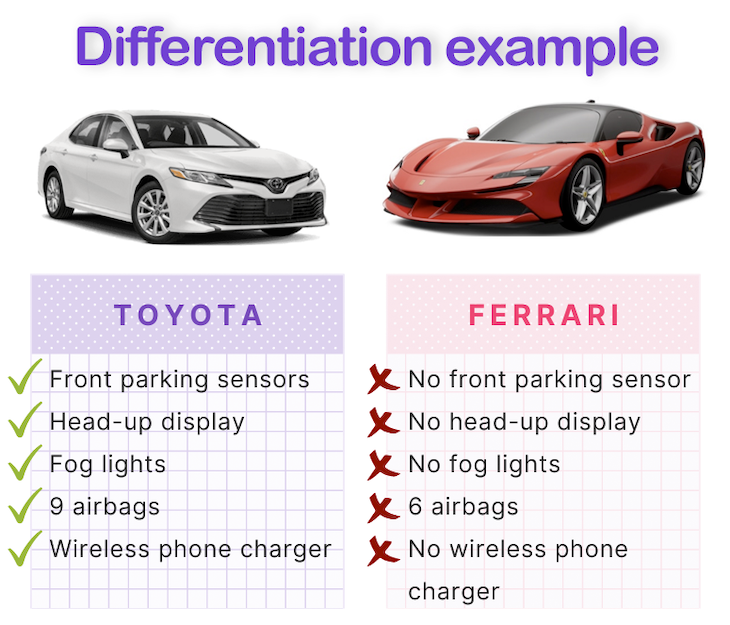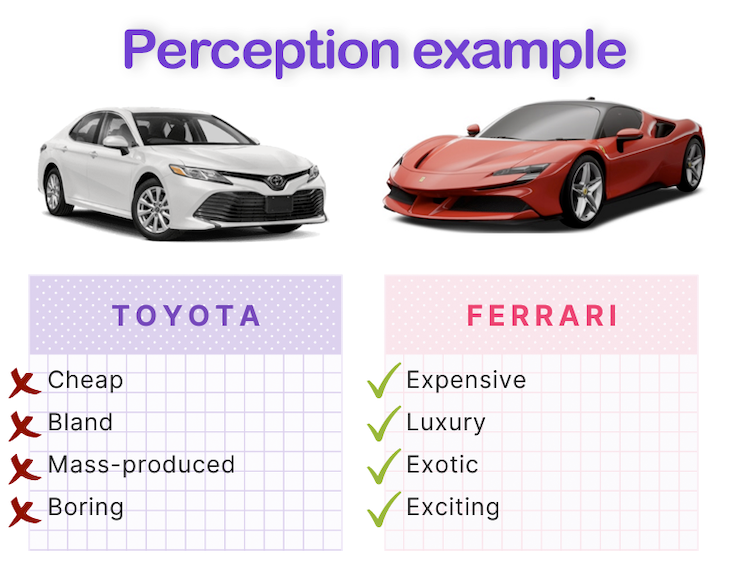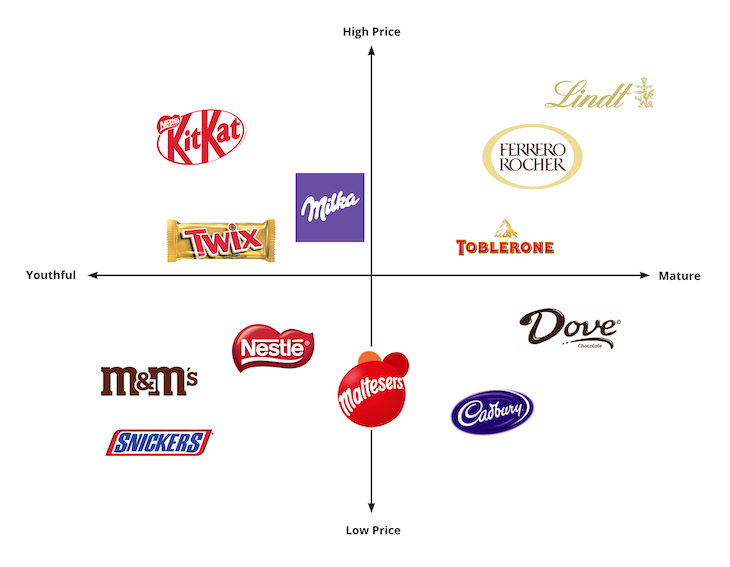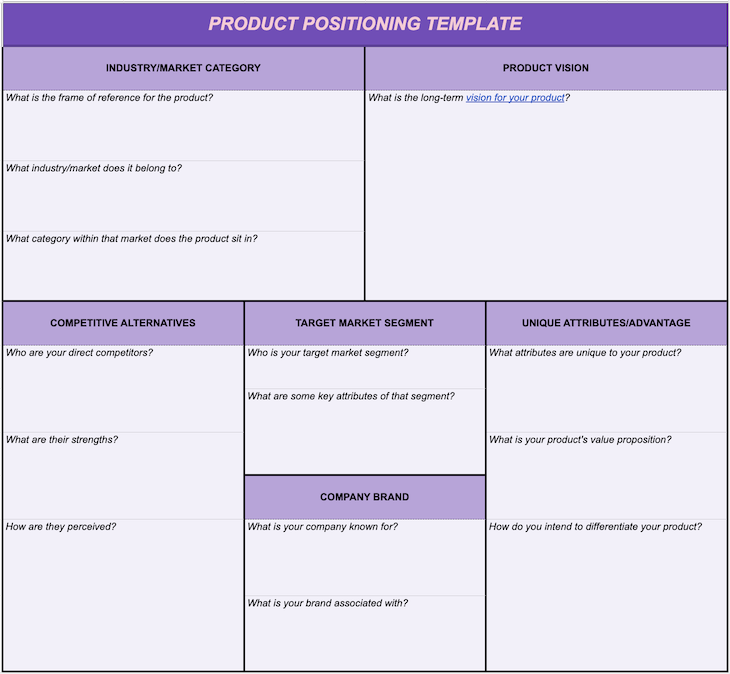The right positioning can transform a struggling product into one that flies off the shelves. That’s because positioning is about perception; calibrating the right perception of your product is paramount to conveying the value it brings over its competitors.
Table of contents
- What is the definition of product positioning?
- Product positioning vs. differentiation
- Why is product positioning important?
- Defining your product positioning strategy
- What is a perceptual map?
- Examples of successful product positioning
- Product positioning template
What is the definition of product positioning?
Product positioning is the act of defining where your product fits in the market relative to its competitors as perceived by your customers.
Let’s break down this definition of product positioning:
- “… where your product fits in the market …” — What is your product and what is it not?
- “… relative to its competitors …” — Who are your competitors and how does your product compare to theirs?
- “… as perceived by your customers …” — This last one is particularly important; product positioning is much more about the perception of your product than any kind of physical differentiation
Product positioning vs. differentiation
Product positioning is not differentiation. A product’s positioning must work with its differentiation, but the are not the same thing.
Here’s simplest way to describe the distinction between product positioning and differentiation:
- Differentiation is tangible
- Positioning is perceptual
In other words, a product’s differentiation is (more often than not) the tangible difference. For example, does your product offer better features than your competitors?
Let’s say you’re comparing the features available in a Toyota Camry versus a Ferrari:

As you can see, the Toyota is superior if you’re solely concerned about functionality and practicality.
Positioning, on the other hand, is perceptual. It has little to do with the actual features and functionality.
How is your product perceived? Is it seen as a luxury? High-end or budget? Is it seen as being of higher quality than your competitors? Or, is it perceived as fun and more innovative?
Let’s look again at the example of the Toyota and the Ferrari:

That’s product positioning — how your product is perceived by the market relative to your competitors.
Now that you’ve determined your product positioning, you can use it to differentiate your product. The two need to go hand-in-hand, but the crucial difference is that positioning is about perception, not physical differentiation.
Why is product positioning important?
Product positioning is important because, while physical differentiation is good, decisions are often made based on how a product is perceived.
For example, purchasing a luxury car or handbag is emotional — not because of how it looks or its design or size, but because of how it’s perceived.
After all, nobody decides against buying a Ferrari because it doesn’t have a heads-up display or wireless charging ; they buy it (at exorbitant price points) because it’s a Ferrari!
The product and brand are positioned such that they carry a certain perception, one that is highly desirable regardless of actual physical features. Leveraging the power of perception can reduce the need for physical differentiation and enable you to demand a higher price point.
Defining your product positioning strategy
The following elements should influence your product positioning strategy:
- Market analysis
- Competitive landscape
- Target market segment
- Company and brand values (and positioning)
- Product vision and value proposition
Market analysis
The first and most important step to defining your product positioning strategy is understanding your market.
While there is no single way to conduct market analysis, some core questions you might explore include:
- Who are the core demographics in your market? Are they students? Affluent families? Retirees?
- What regulations and laws do you need to consider?
- What are the market trends? Is the market growing o shrinking? Perhaps undergoing a major transformation or a period of disruption?
- How much is the market impacted by external forces? What are the political, geographical, and economic impacts?
- What the assumptions, risks, and uncertainties about the market and its future?
Competitive landscape
Product positioning is all about how your products are perceived in relation to their direct competitors. Therefore, it’s paramount to have a good understanding of your competitors.
Of course, you want to build a deep understanding of your competitors, their strengths and weaknesses, and differentiation. Equally importantly, you want to analyze your competitors’ strategy and how they are positioned in the market.
Building a holistic picture of the competitive landscape can help you identify positions in the market that may be saturated or underserved. A great tool for this is perceptual mapping (more on that later).
Target market segment
Defining your target market segment is core to product positioning. For example, let’s say you want to position your product as a luxury item, but your core target market are teenagers. Needless to say, few of them are likely to be able to afford your product.
Another example would be a B2B product aimed at early-stage startups versus one that targets large enterprises. The latter would be more focused on being perceived as safe, secure, and capable. The former would be more concerned with positioning itself as youthful and fun.
Company and brand values (and positioning)
Your product’s positioning will be heavily influenced by your company brand and its current positioning.
For example, Apple positions itself as innovative and creative and seeks to target that market. For a long time, Apple leveraged this reputation to differentiate itself from other computer brands and capture a customer base of creative professionals, from musicians to artists and the like.
As such, Apple’s products also live and breath this ethos: they are aesthetically pleasing, often colorful, and carry a design that is unlike any of their competitors.
Product vision and value proposition
Finally, your product vision and value proposition play a key role in product positioning. Understanding the key differentiator — your moat — is core to defining what makes your product unique in the market. An effective product position will hone in on this and amplify it.
What is a perceptual map?
One of my go-to tools for understanding the market to find the ideal product positioning is a perceptual map.
Perceptual mapping, also known as market mapping, is a diagrammatic technique used to visualize the relative positioning of competitive products. Typically in the form of a 2×2 matrix, perceptual maps seek to map out direct competitors’ positioning relative to each other.
Perceptual maps can help you identify gaps in the market, crowded positioning, and when it may be time to reposition.

The axis on a perceptual map will vary depending on your market, products, and customers.
For example, you might map your products based on whether they are perceived as:
- Cheap <> Expensive
- Low- <> High-quality
- Youthful <> Mature
- Fun <> Serious
- Small <> Large
- Common <> Rare
There’s no perfect science to creating a perceptual map. However, a perceptual map should be informed by research — namely, competitive analysis and customer research. Using this data, you will need to determine what attributes are important for your customers and how they perceive products in the market.
If you wish, you can also validate your perceptual map through perception-based questions as part of customer interviews.
Examples of successful product positioning
In her book Obviously Awesome, April Dunford shares a personal story about the impact that the right positioning can have.
Working in a startup for a B2B database product, the company were struggling with sales. Although the product was superior to its competitors, the company found that customers often did not understand the value the product would bring over their current database solution. Finally, Dunford’s team met with a prospect who argued that the product was not a database at all, but a business intelligence tool.
By repositioning the product as a business intelligence tool, the sales team saw immediate results. Once prospects stopped comparing the product to their existing database, they began to understand the problem the product was designed to solve and the value it could bring.
As you can see, positioning your product correctly can be a game changer. Apple, Nike, Lush, and Patagonia are all examples of companies that have done product positioning exceptionally well.
Let’s dive a bit deeper into each product positioning example.
Apple (MacBook)
Apple positions itself toward creative individuals by leveraging its reputation as an innovative company. It dominates this position in the market so well that you would be hard-pressed to find a designer who doesn’t use a MacBook.
This positioning translates into all aspects of the MacBook — from the applications aimed at creative industries, such as Final Cut Pro for video editing and Logic Pro for music, to its sleek design and unique features that challenge the norm.
Nike shoes
Nike positions itself as brand for elite athletes. From its tagline, “Just Do It,” which models its positioning to push the limits of human performance, to the products themselves, which are frequently the go-to choice for athletes.
Lush
Lush is famous for their handmade, animal- and chemical-free products. They position themselves as a sustainable and ethical company that does not do animal testing and creates products that are not only good for you but for the environment too. This translates to Lush’s unique shop designs and the products themselves.
For example, you will find no packaging in a Lush store besides being wrapped in recycled paper at payment. The products themselves are imperfect and fragile, often sporting blemishes. This doesn’t detract from the product; in fact, it plays nicely into its positioning, promoting the fact that products are handmade and chemical-free.
Patagonia
Patagonia made headlines a couple of years ago when they launched an ad campaign Black Friday titled “don’t buy this jacket.” The campaign was a lobby against fast fashion and to promote sustainability.
Patagonia’s company mission leads the company to participate in activist and sustainability work. This translates into their products and services, from 100-percent recycled material to their free repairs service.
Product positioning template
Defining your product positioning strategy starts with critical consideration around the following elements:
- Your product vision
- What is the long-term vision for your product?
- Industry/market category
- What is the frame of reference for the product?
- What industry does it belong to?
- In what category within your market/industry does it sit?
- Competitive alternatives
- Who are your direct competitors?
- What are their strengths?
- How are they perceived?
- Target market segment
- Who is your target market segment?
- What are some key attributes of that segment that your product will tap into?
- Unique attributes/advantage
- What attributes are unique to your product?
- What is your product’s value proposition?
- How do you intend to differentiate your product?
- Company brand
- What is your company known for?
- What are the key attributes that your brand is associated with?
Download a customizable Google Sheets version of the product positioning template below:

Conclusion
Product positioning can make or break your product. If your position is poor in the market, your product will sink.
Remember that to obtain the right positioning, you need to have a good understanding of your market, customers, and competitors. A great tool to help you visualize this is known as perceptual mapping. It can help you identify saturated positions in the market and underserved ones, helping you find the ideal positioning for your product.
The post What is product positioning? Examples, strategies, and template appeared first on LogRocket Blog.
from LogRocket Blog https://ift.tt/5Kg3VYZ
Gain $200 in a week
via Read more



